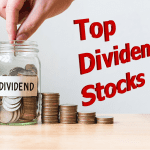What is Dividend Income: 7 Things You Need to Know
By: Ned Piplovic,

While even the most inexperienced investors understand the basic concept of investing for asset appreciation, many are not sure how dividends work, why companies pay dividends or what are advantages of investing in dividend income stocks.
The points about dividend income investing basics below might seem elementary to experienced investors. However, new investors, and especially novices to dividend income investing, should review the seven things that every dividend investor needs to know and treat that information as a primer on which to build their dividend income investing expertise.
Below is a list of seven basic things that every investor needs to know about how dividends work before embarking on the search for equities with the best potential to achieve a return on investment that matches an investor’s individual portfolio strategy.
#1 What Is Dividend Income?
Dividend income is a method by which equities distribute a portion of their assets and earnings to investors. While dividend is a common term used for all dividend income distributions, there are technical differences between true dividends and distributions.
The term dividends technically applies only to dividend income distributions made by a specific type of equity. Mutual funds and C-Corporations are two examples of equities that pay dividends. Alternatively, equities like S-Corporations, limited liability corporations, trusts, partnerships and estates technically pay distributions.
While there many small differences between dividends and distributions, there are two main aspects that differentiate the two payment types. Dividends are generally paid from an equity’s earnings. However, distributions are generally equity or interest distributions.
The other main difference is in the way that the Internal Revenue Service (IRS) treats dividend income. Distributions are included in an investor’s cost basis for calculating taxable income. However, dividends are not included in the cost basis of the original stock purchase.
While the distinctions indicate the source of the dividend income and taxation impact, investors sometimes use the terms interchangeably and generally prefer to use the term dividend for both types of dividend income. Therefore, the term dividend will represent both dividends and distribution in the rest of the text below.
#2 Dividend Yield alone is not sufficient for choosing good dividend income stocks
The dividend yield is the first metric investors consider when seeking dividend income stocks. As the ratio of the total annual dividend payouts per share and the current share price, the dividend yield can be calculated fairly easily and is readily available in financial reports and on financial websites.
However, while very informative for initial assessment of dividend income payouts, the dividend yield requires additional information to confirm an equity’s validity as a potentially profitable investment. A very high dividend yield rate does indicate an equity with a high dividend income stream. However, without considering the share price trend, investors might enjoy high dividend income distributions on one end and loose considerably more because of a sharply declining share price.
An increasing dividend will also increase the dividend yield, which is a positive indication of a rising income for potential investors. However, because the share price is inversely related to the dividend yield, a shareprice drop will also raise the dividend yield and give misleading indication of a valuable investment opportunity.
Therefore, the simplest solution for investors is to evaluate an equity’s total return, which shows combined gains from asset appreciation and dividend income over a certain period. A total return that exceeds the dividend yield is a good indication that an equity might be good candidate for further consideration
#3 Dividend income distributions must be sustainable
The dividend payout ratio is the easiest and the simplest indicator of dividend sustainability. The ratio indicates the share of earnings or equity that a security pays out as dividend income distributions.
Certain securities, such as C-corporations or limited liability companies (LLCs), choose freely the portion of their earnings to pay as dividends. This decision might be included in the company’s dividend policy, or the company’s officers and board of directors can determine the dividend ratio every period based on the company’s financial results.
However, other types of equities, such as mutual funds or real estate investment trusts (REITs), must meet specific distribution requirements to maintain their tax-favorable status. For instance, REITs “must distribute at least 90 percent of their taxable income to shareholders annually” to maintain their exemption from corporate tax liability.
#4 The ex-dividend date is the most important date for dividend income investors
The dividend distribution calendar contains four dates: declaration date, ex-dividend date, record date and pay date. However, the ex-dividend date is most crucial to claim the dividend distributions.
Equities gather their shareholders of record lists for dividend distribution on the record date. The current transaction settlement period for equity trading requires that all equity trades must be settled no later than two trading days after the trade is made. Therefore, investors must claim stock ownership two days before the record date, or one day before the ex-dividend date to claim eligibility for the subsequent round of dividend income distributions.
Any investor that buys shares of an equity on the ex-dividend date can not claim stock ownership until the following trading session and must wait until the following period to receive the dividend distribution. Alternatively, the investor that sells the shares on the ex-dividend date is considered the owner and is in line to receive the dividend income paid in that period.
#5 Dividend distributions come in different forms
Equities have the option to distribute dividends in several different forms. However, because of their simplicity and ease for distribution, cash dividends are the most common type of dividend distributions. For cash distribution, the equity simply mails checks to its stakeholders or initiates electronic funds transfers to the investors’ brokerage or investment account.
In addition to cash dividends, equities can disseminate their dividends as in-kind distributions. In-kind dividend distributions include stock dividends, property dividends, bonds of the company distributing dividends, bonds of a different corporation, government bonds, accounts receivables and promissory notes.
Because of their advantages, stock dividends are the most frequently-used type of in-kind dividend distributions. The main advantages of stock dividend distributions for investors is that the IRS treats stock dividends as stock splits. Therefore, stock dividends carry no income liability in the year of distribution.
The investors incur tax lability only when the shares received as dividends are sold. An additional investor benefit is that all profits from stock sales are taxed at capital gain tax rates, which are generally lower than ordinary income rates.
The company distributing the dividends also benefits from using stocks as a form of dividend distributions. Distributing stocks does not have any effect on the company’s cash position or cash flow. Moreover, the company does not even need to have cash on hand to distribute stock dividends.
#6 Qualified dividends versus ordinary dividends
Unless specifically designated as qualified dividends — shown in box 1b of Form 1099-DIV — the IRS generally treats dividends as ordinary. Ordinary dividends are subject to taxation at ordinary income tax rates.
However, the IRS treats some dividend distributions that meet specific requirements as qualified dividends. These dividends enjoy the benefit of taxation at the lower capital gains rates.
Generally, only dividends paid by U.S. corporations can be qualified dividends. However, under certain conditions even dividends by some foreign companies can obtain the “qualified” status. The IRS Publication 550 provides all details and conditions dividends must meet to attain the qualified designation.
#7 Special Dividends
Occasionally, equities will distribute extra dividend payouts in addition to their regular monthly, quarterly, semiannual or annual distributions. These extra dividend distribution, also called special dividends, distribute unexpected or one-time extraordinary earnings or assets. Some examples of special dividends are liquidation of investments, sales of business divisions, lawsuit awards and similar items.
Dividend income distributions can supplement the growth of an income portfolio and boost total returns on investment. Therefore, with just the seven basic points above, even novice investors can begin to pursue the exciting world of dividend income investing with confidence. However, these basic points are just the foundation on which investors new to dividend distributions can build their knowledge and investing expertise in search if maximum returns.
Dividend increases and dividend decreases, new dividend announcements, dividend suspensions and other dividend changes occur daily. To make sure you don’t miss any important announcements, sign up for our E-mail Alerts. Let us do the hard work of gathering the data and sending the relevant information directly to your inbox.
In addition to E-mail Alerts, you will have access to our powerful dividend research tools. Take a quick video tour of the tools suite.








 Connect with Ned Piplovic
Connect with Ned Piplovic
